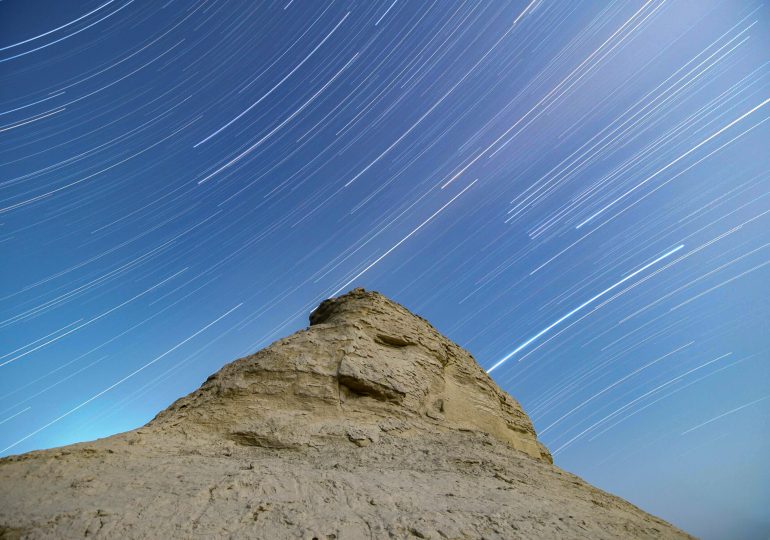Harvard astronomer Fred Whipple thought he did not have much to show for his night’s labors on Oct. 11, 1983. Yes, working with NASA’s Infrared Astronomical Satellite, he had discovered an entirely new cosmic object—which is always a nice thing to put on the scientific tote board. But that object was an unremarkable one. Measuring only 5.1 km (3.17 mi.) across and dimly illuminated, it was thought to be either a dead comet—one that had lost its ices and other volatiles after repeated passes by the sun; or a rock comet, which also lacks volatiles, but which nonetheless gives off tail-like particles like a comet does as it approaches the sun and the growing heat gives rise to cracking and splintering of the object.
[time-brightcove not-tgx=”true”]
Whipple gave his new object the name 3200 Phaethon: the 3200 part is a technical designation intended for astronomical catalogs; the Phaethon portion was a nod to the fact that the rocky body moves closer to the sun than any known asteroid—just 21 million km. (13 million mi.) away—leading Whipple to name it after Phaethon, the son of the sun god Helois in Greek mythology. And that should have been that for Whipple’s modest rock.
But 3200 Phaethon turns out to be worth more than just that—and indeed is the source of one of astronomy’s greatest sky shows. The object takes about 1.4 years to make a single rotation through the solar system. In its wake it leaves a dense tail of particles. And once a year, in December, the Earth moves through that debris trail, leading to the spectacle known as the Geminid meteor shower—so named because the direction of the meteors appears to come from the constellation Gemini. The Geminid shower was first observed in the mid-19th century, but it wasn’t until Whipple’s discovery that the source of the phenomenon was understood.
Read more: 15 Breathtaking Photos of Meteor Showers
This year’s Geminid shower promises to be a big one. On poor nights, with partly cloudy skies and a full or near full moon washing out the light of the meteor shower, only about 10 to 20 meteors can be seen per hour. This year, during peak viewing hours—which range from 10:00 p.m. EST on Dec. 13 to 7:00 a.m. EST on Dec. 14—the skies across much of the country are predicted to be clear. The moon, meanwhile, will be in one of its dimmest phases—a young waxing crescent—meaning little natural light pollution. That makes for quality viewing.
The best observation techniques involve lying flat on your back with your feet facing south, bundling up in a sleeping bag (it is December after all) and giving your eyes about 30 minutes to adjust to the dark—which means no looking at your phone. If you follow these rules and you do get lucky with clear skies, you could see up to 120 meteors per hour.
The Geminids are not the only meteor shower show in town. There is the Leonid meteor shower, which occurs every November, and generally produces a modest 10 to 15 meteors per hour. During one historic episode on Nov. 17, 1966, however, the Leonids gave rise to something of a meteor cyclone, producing thousands of meteors per minute during one 15-minute span. There is, too, the Perseid meteor shower, which is active each summer from July to September, and draws its debris trail from comet Swift-Tuttle. And there are others as well: the Lyrid meteor shower, which is active in April and gets its meteor debris from the Comet Thatcher; and the Quadrantids shower, which is fed by the debris from asteroid or rock comet 2003 EH1 and is active from December to January. And there will also be the Ursid meteor shower, which will follow hard on the heels of the Geminid, on Dec. 22 to 23.
But the Geminids are special. The flecks that break off from 3200 Phaethon are comparatively large—three grams by cubic centimeter (a measure of weight by volume) compared to 0.3 grams per cubic centimeter for cometary flakes. That size advantage makes for brighter, heavier, longer-burning meteors. What’s more, while most meteors are white or nearly colorless, the Geminds shine a bright yellow or green, due to the interaction of some of their key components, especially oxygen, magnesium, and nickel, with the Earth’s atmosphere.
The Geminid meteor shower is long in the making—requiring a full revolution of the Earth around the sun to pass through 3200 Phaethon’s tail; but it’s quick to pass, peaking just from Dec. 13 and 14 this week. So grab the shy show during the fleeting time it’s here—or be prepared to wait another year for one of its dazzling performances.
Leave a comment
















